Single Mode Fiber Optic Circulators
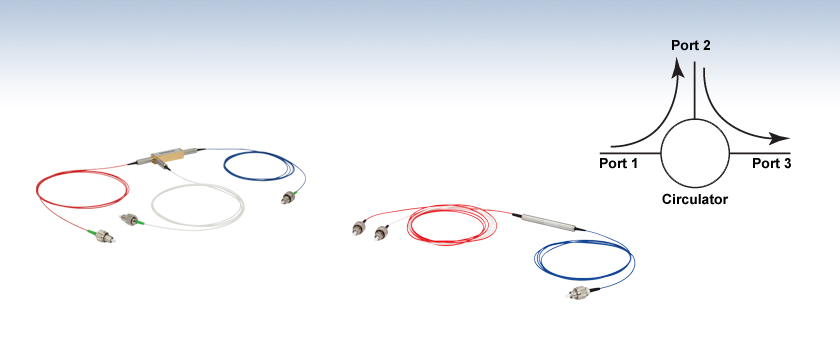
- Non-Reciprocating, Unidirectional Operation
- Wavelength Ranges Centered Around 1064 nm, 1310 nm, or 1550 nm
- Single Mode Fiber Available with Bare Fiber, FC/PC Connectors, or FC/APC Connectors
CIR1064-APC
CIR1310-APC

Please Wait
| Selection Guide for Circulators |
|---|
| SM Circulators |
| 1310 nm SM Circulator for OCT |
| PM Circulators |
| 1064 nm High Power Circulator |
| 1550 nm High Power Circulator |
Applications
- Add-Drop Multiplexing
- Fiber Sensors
- Bidirectional Pumping
- Bidirectional Signal Transmission Systems
- Coupling In-Line Chromatic Dispersion Compensation Devices
Thorlabs’ Single Mode (SM) Optic Circulators are non-reciprocating, one directional, three-port devices that are used in a wide range of optical setups and for numerous applications. Our SM optical circulators have a center wavelength of 1064, 1310 (O-Band), or 1550 nm (C-Band). Additionally these SM optical circulators are available unterminated, with FC/PC connectors, or with FC/APC connectors. Thorlabs also offers Polarization-Maintaining (PM) Fiber Optical Circulators.
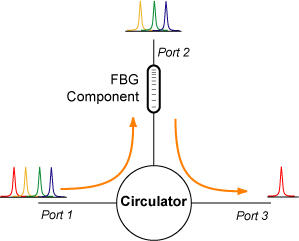
Circulator used to drop an optical channel from a DWDM system using a Fiber Bragg Grating.
An optical circulator is analogous to an electronic circulator and both perform similar functions. An optical circulator is a three-port device that allows light to travel in only one direction. A signal entering to Port 1 will exit Port 2 with minimal loss, while a signal entering Port 2 will exit Port 3 with minimal loss. Light entering port 2 experiences a large amount of loss at port 1, and light entering port 3 experiences a large amount of loss at ports 2 and 1. Optical circulators are non-reciprocal devices. This means that any changes in the properties of the light caused by passing through the device are not reversed by traveling in the opposite direction.
Because of its high isolation and low insertion loss, optical circulators are widely used in advanced communication systems as add-drop multiplexers, bi-directional pumps, and chromatic dispersion compensation devices.
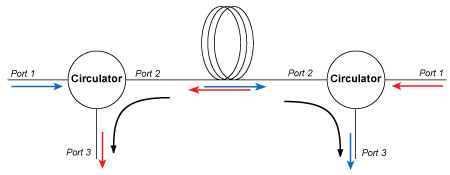
Circulators can be used to send optical signals through a single fiber in two directions.
The example to the left depicts the use of a circulator to drop an optical channel from a DWDM system using a Fiber Bragg Grating (FBG). The input DWDM channels are coupled into Port 1 of the device with a FBG device connected to Port 2. The single wavelength reflected from the FBG then reenters the circulator in port 2 and is routed accordingly to Port 3. The remaining signals pass through the FBG and exit on the top fiber.
Circulators can also be used to send optical signal in two directions down a single fiber. A circulator is located at both ends of the fiber. Each circulator functions to add a signal in one direction while removing the signal in the other. See the example to the right.
For custom wavelength and connector options please contact Tech Support.
| Item # Prefix | CIR1064a | CIR1310a | CIR-1310-50 | 6015-3a |
|---|---|---|---|---|
| Optical Specifications | ||||
| Wavelength Range | 1050 nm - 1070 nm | 1280 nm - 1340 nm | 1280 nm - 1400 nm | 1525 nm - 1610 nm |
| Insertion Loss | 2.1 dB Maxb | 0.8 dBb | 1.6 Maxc,d | 0.8 dB Typical, 1.0 dB Max |
| Isolatione | ≥20 dBb | ≥40 dBb | 28 dB Minc | >40 dB Min |
| Directivity (1-3) | ≥45 dB | ≥50 dB | 50 dB Min | >50dB |
| Polarization Dependent Loss | ≤0.2 dB | ≤0.15 dB | 0.2 dB Max | ≤0.1 dB |
| Polarization Mode Dispersion | ≤0.05 ps | ≤0.1 ps | 0.05 ps Max | ≤0.05 ps |
| Chromatic Dispersion | - | - | 3 ps/nm Max | - |
| Return Loss | ≥50 dB | ≥50 dB | 45 dB Mind | ≥50 dB |
| Maximum Power Level (CW) | 300 mW | 300 mW | 500 mW | 500 mW |
| Mechanical Specifications | ||||
| Package Dimensions | 1.34" × 0.33" × 0.33" (34.0 mm x 8.4 mm x 8.4 mm) |
Ø0.22" × 1.97" (Ø5.5 mm x 50.0 mm) |
Ø0.22" x 1.50" (Ø5.5 mm x 38.0 mm) |
Ø0.22" x 1.99" (Ø5.5 mm x 50.5 mm) |
| Fiber | HI1060, 900 µm Loose Tube | SMF-28e+, 900 µm Loose Tube | SMF-28 Ultra, 900 µm Loose Tube | SMF-28 Ultra, 900 µm Loose Tube |
| Length | 1.0 m +0.075/-0.0 m | 1.0 m +0.075/-0.0 m | 1.0 ± 0.1 m | 1.0 m +0.075/-0.0 m |
| Operating Temperature | 0 to 70 °C | 0 to 70 °C | 0 to 70 °C | 0 to 70 °C |
| Storage Temperature | -40 to 85 °C | -40 to 85 °C | -40 to 85 °C | -40 to 85 °C |
| Operating Relative Humidity | 5% - 60% | 5% - 60% | 5% - 95% | 5% - 60% |
| Storage Relative Humidity | 5% - 85% | 5% - 85% | 5% - 95% | 5% - 85% |
| Posted Comments: | |
user
(posted 2024-03-21 14:04:47.613) Hello, is it OK to fire a short pulses [10-100 ns, 10-30 W peak, 10 kHz repetition frequency] into SM Fiber Optical Circulators, 1550 nm? ksosnowski
(posted 2024-03-22 02:38:34.0) Thanks for reaching out to Thorlabs. The component fibers used for these devices are found in the specs tab. Each of the component fibers has a damage threshold listed on their page for pulsed and CW damage. Additionally, we provide a short article describing the mechanisms and consequences for damaging a fiber optically, since scratches or debris can lower the threshold artificially. For pulse lasers, we can only guarantee performance following our spec for the bare fiber; while the average power seems low enough in this scenario, fast laser pulses like this must be applied at the user's discretion. We have not tested these assemblies for other potential damage mechanisms internal to the circulator so we cannot guarantee a safe pulsed damage threshold limit. Adam Wright
(posted 2023-07-20 21:40:03.297) You all should make 1550 fiber circulators that are boxed, similar to the TN1550R5A2. That would be awesome jdelia
(posted 2023-07-21 11:34:01.0) Thank you for contacting Thorlabs and for providing this valuable feedback. I can certainly forward your request over to our design engineers via our internal suggestion forum for consideration as a future product. Conner Phillips
(posted 2023-07-11 09:17:27.597) Greetings,
Could you provide feedback on whether the 6015-3-APC would be appropriate to use over the bandwidth 1450-1690 nm? cdolbashian
(posted 2023-07-13 02:24:18.0) Thank you for reaching out to us with this inquiry. While we do not advertise this circulator down to 1450, it is made with SMF28-ULTRA fiber, which works perfectly well in terms of transmission. At worst, you will get some additional insertion loss (up to 1.5dB compared to .8 of the device in-spec). Md Sikandar Ansari
(posted 2021-09-12 01:17:32.98) I want to purchasing please contact me +91-8585068295 YLohia
(posted 2021-09-14 03:44:02.0) Hello, thank you for contacting Thorlabs. Please see our list of international distributors here: https://www.thorlabs.com/distributors.cfm. user
(posted 2021-06-16 05:43:58.42) Hello,
We would like to know whether or not the "6015-3-FC" series will support input power from a picosecond pulsed source peaking at 200W with an average power of 100mW.
Regards. YLohia
(posted 2019-07-03 03:28:58.0) Hello, thank you for contacting Thorlabs. The component fibers used for these devices are found in the specs tab. Each of the component bare fibers has a damage threshold listed on their page for pulse an CW damage. Additionally, we provide a short article describing the mechanisms and consequences for damaging a fiber optically. For pulse lasers, we can only guarantee performance following our spec for the bare fiber, as connectorizing the fiber drastically decreases the damage threshold. If you plan to use this with a picosecond pulse laser, please do so at your own discretion. abigail.sandquist
(posted 2019-01-07 12:14:12.747) Hello,
I am interested in the operational history of this product. Do you have some examples of how this product has been used in the field, and how it has performed? nbayconich
(posted 2019-01-10 11:17:23.0) Thank you for contacting Thorlabs. Most of our circulators are used in the lab rather than in the field. I do not have specific application examples to share for these circulators other than that some are used in add/drop multiplexers & optical amplifiers. phani
(posted 2018-02-20 22:33:35.86) Hello,
Could you please let me know the prices for the fiber optic circulators for the following wavelengths:
1. 532 nm
2. 650 nm
3. 980 nm
Thanks!
Best Regards,
Phani. YLohia
(posted 2018-03-30 09:14:43.0) Hello Phani, thank you for contacting Thorlabs. I will reach out to you directly regarding the possibility of offering this. giovanni.cantatore
(posted 2018-02-20 13:26:07.713) What is the Mode Field Diameter at the exit of port 2 of the CIR1064-FC circulator? tfrisch
(posted 2018-02-20 01:25:37.0) Hello, thank you for contacting Thorlabs. CIR1064-FC uses HI1060 fiber which has a MFD of 6.2±0.3µm at 1060nm. This is true of all 3 ports. mjburek
(posted 2017-05-20 17:26:21.387) Is it possible to develop a fiber circulator for visible light, with either S630, S630-HP or SM600 fiber? This product would be highly valuable for our work. Thanks! nbayconich
(posted 2017-06-06 03:21:44.0) Thank you for contacting Thorlabs. We currently do not offer a stock option of our fiber circulators in the visible wavelength range but we can offer a custom version circulator. Fiber circulators at the visible wavelength range are very wavelength dependent and will have a smaller bandwidth. A Techsupport representative will contact you directly. hsun-chiahsu
(posted 2016-09-12 18:21:46.1) I'd like to ask if you can customize a fiber-based optical circulator for 980 nm cnetral wavelength (covering range from 970 nm - 990 nm). If yes, what would the price can be? tfrisch
(posted 2016-09-15 05:29:14.0) Hello, thank you for contacting Thorlabs. It looks like you are already in contact with Tech Support about this request. user
(posted 2016-06-20 09:44:00.993) Is the light arriving from port 3 directed to port 1? What is the insertion loss? (port3-->
1)
Many thanks! besembeson
(posted 2016-06-22 09:04:53.0) Response from Bweh at Thorlabs USA: Port 3 is an output port and light arriving port 3 will have high losses through port 1 or port 2. We have not measured that as it will not be a typical configuration for usage. For high throughput, port 1 exits at port 2 and port 2 exits at port 3. yinian-zhu
(posted 2013-07-10 12:02:38.553) I need a formal quotation of Fiber Optic Circulator, 1050 - 1070 nm, SMF, FC/APC for my purchase order here. Thanks. jlow
(posted 2013-07-11 08:10:00.0) Response from Jeremy at Thorlabs: We will get in contact with you to provide a formal quote. You can also reach us at sales@thorlabs.com to request a formal quote in the future. sharrell
(posted 2012-07-19 12:24:00.0) Response from Sean at Thorlabs: Thank you for pointing out the inconsistency with our circulator diagrams. We are currently reviewing these diagrams and are working to recreate them properly. If you have any questions regarding the operation of our circulators, or if you wish a notification of when this update is complete, please contact us at techsupport@thorlabs.com. user
(posted 2012-07-17 18:08:46.0) Hi, you might want to change your cartoons to reflect the actual circulator you sell -- it's a little confusing since in the cartoon the light is directed 90 deg twice, while in the actual circulator, the light goes straight through and then is directed 90 deg just once. Small thing; it got me, though! Went back to the PDF and realized what was going on. Maybe can save someone else the trouble. Best, Luke user
(posted 2011-12-09 13:41:52.0) A response from Tyler at Thorlabs: You are correct, each time the light enters the circulator it experiences the insertion loss. Thank you for using our online feedback forum. bmills
(posted 2011-12-08 16:46:08.0) Can you explain the insertion loss numbers? Do you lose 1.3 to 1.9dB going from port 1 to port 2, and then lose another 1.3 to 1.9dB going from port 2 to port 3? klee
(posted 2009-11-12 10:36:49.0) A response from Ken at Thorlabs to pratheep.r29: We will check if this is possible. Meanwhile, please send your full contact information to techsupport@thorlabs.com so we can send you a quotation if this is indeed possible. pratheep.r29
(posted 2009-11-12 01:51:08.0) I need a 3-port custom made circulator with port1 to port2 having a wide spectral range i.e. 900nm~1600nm, port2 to port3 having a spectral range 900nm~1100nm. klee
(posted 2009-10-13 14:08:00.0) A response from Ken at Thorlabs to kevin.h.wilson: Which circulator do you have? Only the CIR-1310-50-APC is designed for 1310nm. The 6015-3 are for 1550nm while the OC-L-xxxx are for 1064nm or 1550nm.
The yellow/orange arrows just “help” explain the path the light takes. The coil in the middle is just a fiber. kevin.h.wilson
(posted 2009-10-13 09:20:47.0) Two things.
First have you or any of your customers ever used circulators on a standard 1gb-Ethernet network at 1310? I have tried the suggeted configuration and get intermittant behavior.
Second, in figure 2 of the circulators page I understand the red and blue arrows, but what are the yellow/orange arrows representing? Is that coil in the middle a sensor? |

- Wavelength Range 1050 - 1070 nm
- Single Mode Fiber With No Connectors, FC/PC Connectors, or FC/APC Connectors
Thorlabs' 1064 nm SM Fiber Optic Circulators are available unterminated, with FC/PC connectors, or with FC/APC connectors. The FC/PC and FC/APC connectors have a 2.0 mm narrow key. These circulators have a maximum power handling of 300 mW (CW).

- Wavelength Range From 1280 - 1340 nm or 1280 - 1400 nm
- Single Mode Fiber With No Connectors, FC/PC Connectors, or FC/APC Connectors
Thorlabs' 1310 nm SM Fiber Optic Circulators are available unterminated, with FC/PC connectors, or with FC/APC connectors. The FC/PC and FC/APC connectors have a
2.0 mm narrow key. Our CIR1310, CIR1310-FC and CIR1310-APC circulators have a maximum power handling of 300 mW (CW).
The CIR-1310-50-APC broadband fiber optic circulator is specifically designed for OCT applications. This circulator boasts a broader wavelength range than our standard 1310 nm SM fiber optical circulator and has a maximum power handling of 500 mW (CW). For more information, please see our full presentation on our circulator for OCT.

- Wavelength Range From 1525 - 1610 nm
- Single Mode Fiber With No Connectors, FC/PC Connectors, or FC/APC Connectors
Thorlabs' 1550 nm SM Fiber Optic Circulators are available unterminated, with FC/PC connectors, or with FC/APC connectors. The FC/PC and FC/APC connectors have a
2.0 mm narrow key. These circulators have a maximum power handling of 500 mW (CW).
 Products Home
Products Home














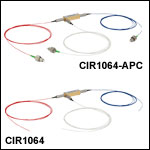
 Zoom
Zoom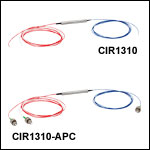
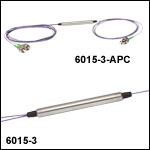
 Single Mode Fiber Optic Circulators
Single Mode Fiber Optic Circulators